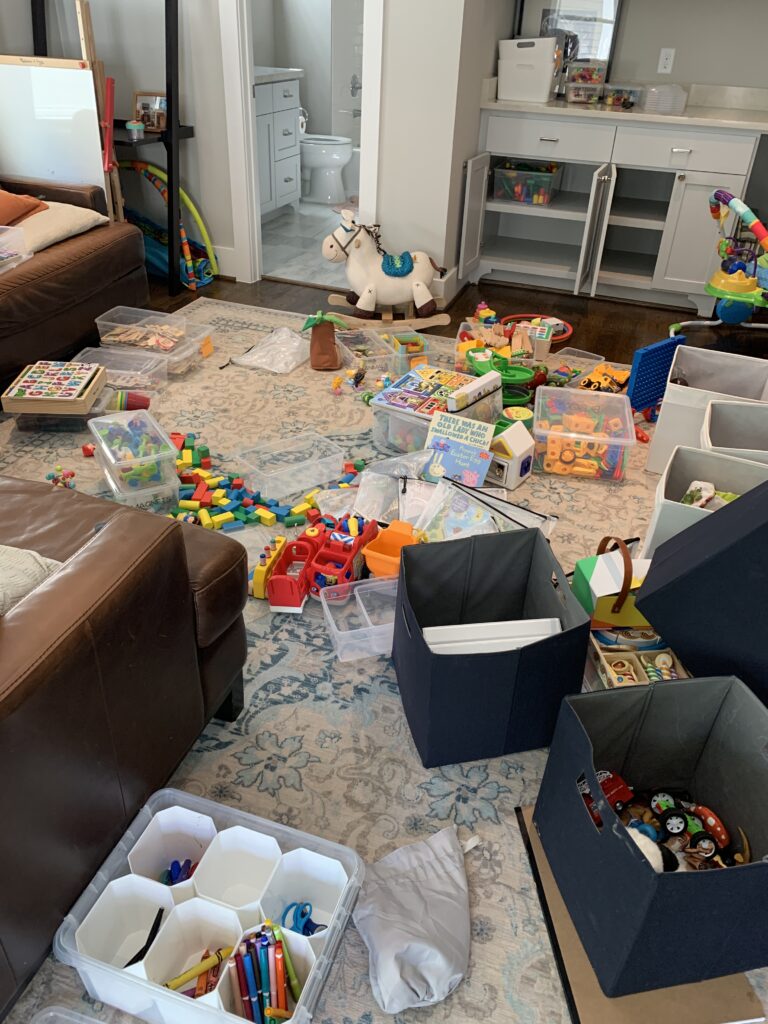I'm Jordan
serving
Houston, TX
what we do
Personalized home organization
titles
Entrepreneur, mom, & wife
get to know me
Playroom Magic: Unveiling the Secrets of Toy Rotation
March 15, 2024
It’s undeniable: we all adore our children and aspire to provide them with the best. Yet, sometimes, that translates into an overflow of toys—be it from us, grandparents, or other family members. Consequently, our play areas morph into chaotic messes that no one wants to tackle.
Enter the concept of toy rotation for your playroom—a game-changer that simplifies life.
Toy rotation simply involves limiting the number of toys available to your children at any given time. This alleviates overwhelm for kids. Ever experienced decision paralysis from too many choices? Our children feel it too. An excess of toys can leave them feeling overwhelmed and unable to decide.
Moreover, it fosters an environment conducive to creative and independent play. By allowing children to immerse themselves in one toy for an extended period, we encourage deeper engagement—a luxury often forfeited amidst clutter. Plus, reintroducing rotated toys can spark renewed interest, akin to having “new” toys all over again.
One of the most rewarding aspects of a toy rotation system, besides its benefits for our children, is the simplified cleanup. As we all know, fewer toys mean less to tidy up!
So, let’s delve into the steps of creating a toy rotation system that you can seamlessly implement in your playroom. Alternatively, if you prefer, feel free to reach out, and we’d be delighted to assist in setting one up for you!

Step 1 | Gather Toys in One Place
Begin by gathering all the toys into a single location, including those that may have strayed into other rooms. Bring all the toys together so you can see what you’re working with.
For younger kids, this is easier to do without them. For older kids, they can definitely help you gather all the toys! Then, you can involve them as much or as little as you’d like in the next step, decluttering.
Step 2 | Declutter (The First Time)
Once assembled, eliminate obvious candidates for removal:
– Discard items with missing pieces or those showing signs of wear and tear.
– Donate toys your children have outgrown or those you simply don’t favor.
This is an opportune moment to assess which toys are surplus to your family’s needs.
For this step, it makes sense to do without kids, depending on their ages. For younger kids, it’s easier to declutter without them. For elementary school kids, I like to have a declutter pile ready to talk to them about. This ensures that you don’t get rid of something they enjoy, but you have made suggestions about what to donate or throw away.
Step 3 | Sort Your Toys
After the initial decluttering, categorize the toys accordingly. This step offers insights into the distribution of toys across various categories. This will give you an idea of what you’re working with.
My categories I usually use are:
- Vehicles
- Building Toys
- Counting and Stacking Toys
- Animals and People
- Baby Dolls and Accessories
- Puzzles and Games
- Books

Step 4 | Declutter (Yes, Again!)
Review the sorted toys once more, ensuring they align with your desired rotation set. This is also an excellent opportunity to confirm the age appropriateness of toys and set aside those that aren’t age-appropriate for your children. These go together and can come out for a younger sibling, if needed, or donated.
Then, review your categories. If you notice you have a lot of vehicles and your kids don’t play with them as much, consider donating some. If you notice a category is light that you’d like more toys in, do some research later and add to birthday and holiday lists for family members to buy!

Step 5 | Create Sets of Toys for Toy Rotation
With categories identified, assemble toy sets comprising 8-10 items each. Consider how toys can complement one another to foster imaginative play.
Display your chosen “current” set prominently in the play area, enticing your children to engage with them. Utilizing shelves like IKEA Kallax can facilitate visibility and accessibility.
Step 6 | Create a Toy Rotation Strategy
Establish a rotation schedule tailored to your children’s age and preferences. Younger children may benefit from bi-weekly rotations, while older ones may prefer longer intervals.
My favorite strategy is whenever I notice my kids aren’t playing with the toys out as much or not playing independently for long periods of time. That signals to me that we need a new set of toys out!
Adapt the strategy as needed based on your children’s responses and evolving interests.

Step 7 | Maintain Your System
Regularly assess and refine the system based on observations of your children’s play habits. Flexibility is key—adjust as necessary to ensure optimal engagement and enjoyment.
Remember, there are no rigid rules—tailor the system to suit your family’s dynamics. And should you seek assistance, don’t hesitate to reach out; we’re here to help you navigate the journey to an organized playroom, either in person or virtually!
In our household, perfection eludes us, but we find what works and adapt accordingly. Embrace what works for you and your family—it’s all about creating a harmonious environment where play thrives.
Brand + Website By Carrylove Designs
Wildely Organized 2024
Based in Houston, TX, Wildely Organized offers compassionate, professional in-home organization services that empower families to live functional lives in a space they love.
blog
Home
about
our work
services
contact
Organize Your Home, the Wildely Way
| Brand + Website By Carrylove Designs